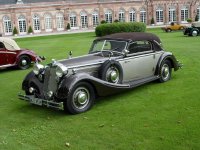This particular car started life as a 1940-1941 Horch 853 sport cabriolet in November of 1945. You have to remember that after the war, anything that was still functional was pressed into service. Having no use for a sports cabriolet, and instead needing a fire engine, the car was converted. The body design was by a company called Lepil from Rousinov near Brno, the acrylic glass roof was built by a local company. This car was converted for the Brno-Komin fire department.
I am not clear on whether the fire department still owns this unit or not, but if it were to find its way into private ownership, it would certainly be re-bodied back into a sports cabriolet, as the high value of the Horch chassis would indeed merit such a restoration.
I appreciate Joaquim's post and he sounds like an expert about this vehicle, however I have some questions
1. Were Germans still building luxury sports cabriolet in 1940-1941? Germany was embroiled in WWII. It would seem that military vehicles would command the focus of auto manufacturers. But perhaps the cabriolet was made for an SS officer? I realize that these cars were cars of choice for the SS, so I guess this was possible.
I see little on this vehicle that looks like a 1940 853 Horch Sport Cabriolet. See picture below of the closest I cold find, 1937 853 Horch Sport Cabriolet.
2. Why was an exotic acrylic glass roof installed? It would seem more logical to have put this conversion effort into additional fire fighting equipment. Seems a strange addition to a fire fighter, a plastic roof would seem a poor idea in a vehicle that puts out fires.
3. Why squander precious post war resources to build a "play toy" fire pump? Why not grab the nearest military truck and build a more powerful fire fighter?
4. Looks like it has a crankshaft mounted pump. This would seem an involved task to mount this to a Horch v12 engine. Were Horch pumps available, or was some other brand mounted?
I just think there is more to this story.



